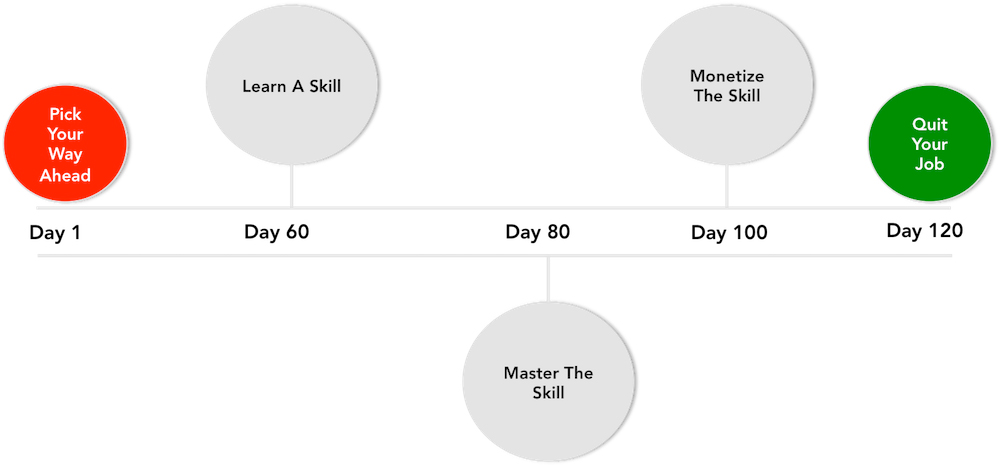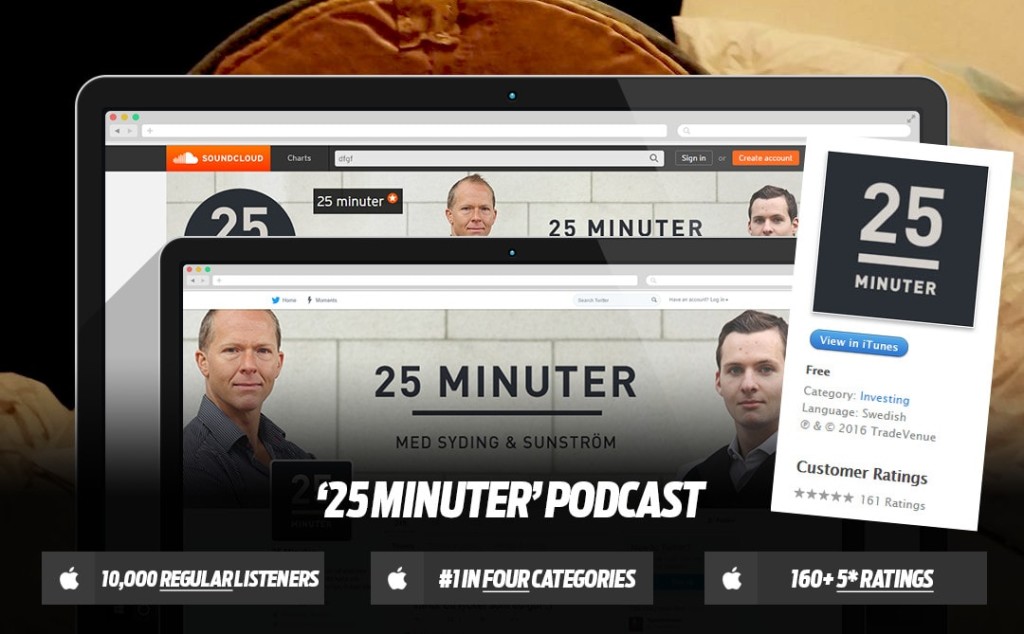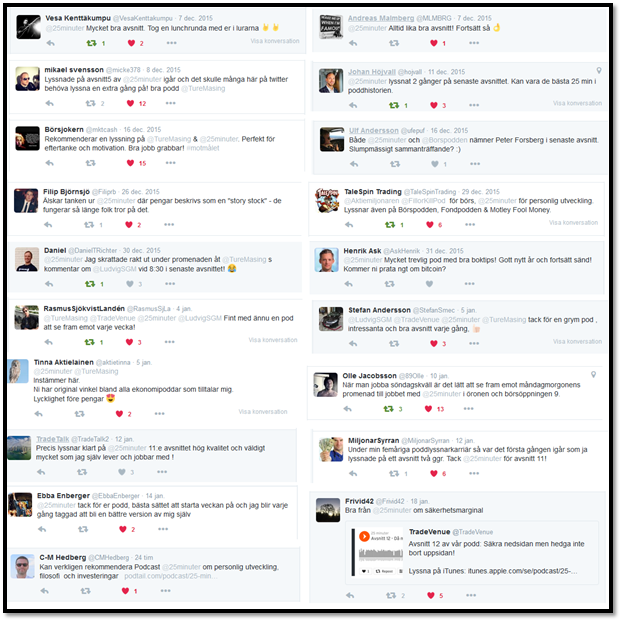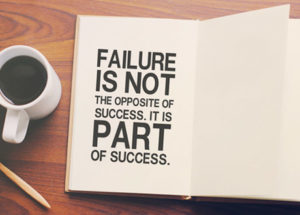![How to Start a Popular Podcast]()
“The unified championship belt” held by my podcast “25 Minuter”. It ranks #1 in All Categories, All, #1 in All Categories, Audio, #1 in Business, and #1 in Education on iTunes New & Noteworthy for Sweden. After 14 weeks.
About 1.5 years ago I wrote an article titled “How to Blast Out Of Obscurity” for StartupBros.
That article was about how I started a decent-sized blog with high readership engagement, in relatively short time while being busy.
Basically, I broke down the process of starting a blog into the fundamental 80/20 activities and showed actionable ways you could do the same—and many people did!
(I know because I received emails from them.)
Today, I wanna walk you through a similar “80/20-activity-process,” for how you can start a popular podcast. This is something I’ve done over the last 3 months, and I didn’t have to put in soul-killing hours to accomplish it. Read on and you’ll find out why.
Here’s What We’ll Cover:
• A Quick Glance at My Podcast: “25 Minuter”
• How to Start a Popular Podcast
• 10 I Things Noticed When Studying the Competition for Ways to Stand Out
• How to Create Your Unique Content Formula
• How to Structure Your First Episode
• How to Become Featured in iTunes New & Noteworthy
• 4 Common Mistakes Podcasters Make
• How to Pace Future Episodes
• 2 Time-Saving Tips
Please note: I’m covering the most important strategic decisions you’ll need to make, NOT all the boring technical stuff. When the time comes for you to do those things, just Google how to do it.
A Quick Glance at My Podcast: “25 Minuter”
My podcast is called 25 Minuter.
25 Minuter (which means 25 minutes, in Swedish) is a podcast about business, career, and personal development. We frequently draw on financial theory and we always have concrete takeaways for the listeners. As suggested by the name, we keep our episodes to 25 minutes.
I say “my” podcast, but it’s really a team effort.
I do the podcast together with Mikael Syding (the beefy guy on the left in the picture below). Mikael is a “retired” hedge fund manager. His hedge fund, Futuris Asset Management, was awarded European Hedge Fund of the Decade.
–They only give out one of those awards every 10 years, and only to one hedge fund.
![25 Minuter Podcast Ludvig Sunstrom Mikael Syding]()
Mikael has listened to tons of podcasts over the years, and because of this he has a good sense of “good podcasting” vs “bad podcasting”. This experience has been invaluable.
We also do our podcast in collaboration with the company TradeVenue, a Swedish investment platform. Having TradeVenue as our strategic partner has been extremely helpful, because it means that me and Mikael have the time to work on our separate business projects, and don’t have to kill ourselves “just” to put out a popular podcast.
(I’ll go into some of the specific benefits of having a strategic partner at the end of the article.)
So far, we’ve received more than 100k downloads on iTunes since we started 3 months ago.
![25 Minuter Libsyn iTunes Downloads Stats]()
[Pictured: Statistics from our Libsyn account, measuring iTunes downloads.]
In total we’ve had maybe 150k downloads, if you count SoundCloud and other podcasting platforms. But iTunes is by far the most important one, so that’s the one we track.
And, as you saw in the image on top, we’re also the #1 ranked New and Noteworthy podcast in 2 categories—plus all categories— simultaneously.
Let me tell you how we did it…
How We Started a Popular Podcast
It started with me doing my homework on the Swedish podcasting industry and then applying some neat stuff—having to do with positioning, differentiation, and target audience—that I learned during the StartupBros Import Empire Summit.
Two guys whom I learned a lot from during the event were Zach Smith (CEO of Funded.Today), who has a solid background in marketing, and the enigmatic serial-entrepreneur Edmund Lowman (whom you already know from StartupBros. If not, read this article).
In particular, two of Edmund’s speeches made an impact on me.
The first one was about his “Business Marketing Checklist” and the other one was about branding; two areas in which Edmund has a proven track record from building 4 successful businesses.
![Edmund Lowman StartupBros Import Empire E-commerce Summit]()
[After the talk I asked Edmund if he would please email me his checklist. He did. But Gmail didn’t show it, so asked him again. Three times! After his 3rd email it showed up in Gmail. It was embarrassing, but I wanted it.]
Edmund talked about companies which had looked at what the competition was doing, paid attention to consumer needs which were not being met, and then decided they would provide an alternative to the industry status quo and meet these needs.
Edmund said his three favorite examples of companies which had done this successfully were:
- Emirates Airline: (by unfailingly providing really good service, though expensive.)
- Evernote: (by using an extreme Freemium model.)
- Tune Hotels: (by being cheap but charging you for everything else. Opposite of Evernote.)
When I talked to Edmund after his speech, he prodded me: “What are others doing that annoy you? Do the opposite!”
He continued: “If everyone else (in the niche or industry) is doing something, it becomes boring. By breaking this pattern you can gain attention from contrast.”
I already sort of “knew” this stuff, but the way Edmund put it made it go “CLICK” inside my head. So when I got back to Sweden I immediately put his advice into action. And it was powerful!
The first thing I did was to find ways for the podcast to stand out from the crowd…
10 Things I Noticed When Studying the Competition for Ways to Stand Out
When I studied the competition of Swedish podcasts I noticed that:
- Most Swedish podcasts don’t do proper cutting or editing, and those who do typically do a poor job at it.
- Many podcasts (not just Swedish) have mediocre sound quality. This is easy to amend.
- They are not practical enough. And when the podcasts are practical, the advice is generally low quality and time-consuming. Episodes often go on for 40-60 minutes, talking around the point.
- Most of the podcasts are just empty banter and gossip (which can work when two celebrities come together to do a podcast, but not otherwise).
- They have unoriginal names. Most of them are called something along the lines of “The [insert niche] Podcast” or “The [insert niche podcast] with [name] & [name]”.
- Most podcasts use cover images of the host(s) or they have some cluttered design.
- Most podcasts do not have a sufficiently clear-cut target audience.
- They typically do not have a unique content formula tailored to differentiate them and benefit their target audience.
- Most of them do a bad job with copywriting (in the headlines and episode descriptions).
- Nearly all podcasts lack logical pacing of episodes and long-term planning.
The most popular podcasts, by comparison, typically do many or all of these things well.
(Note 1: all of these points provide an avenue for differentiation!)
(Note 2: Re #5, we also took a picture like that—as you saw earlier—but we decided not to use it for our profile picture in iTunes because, again, we wanted to use every way possible to stand out from the crowd!)
![25 Minuter Podcast Logo]()
[We think our—simple—logo stands out.]
![Podcast Logo Design Examples]()
[How many “people images” & “cluttered designs” can you spot in this image?]
There was—or so it seemed to us—an apparent gap in the market for a short and practical podcast centered around education, business, and self-development thinking—grounded in financial theory.
We came to this conclusion by our own reasoning and observations, not by mindless mimicry.
We came to this conclusion because we—as Edmund said—looked at what was not being done, and decisively decided that we would provide that thing.
Don’t Forget the Music!
Oh yeah, I almost forgot. Thanks for reminding me, you’re the best!
For music, we noticed—(unfortunately)—that most podcasts actually do a pretty good job. So, that means it would be difficult for us to stand out there…
But that doesn’t mean music isn’t important—it is important. And ours is cool.
So what kind of music do you want? It depends on the nature of your podcast. But generally, you want something that is UPBEAT and energizing, without being hard on the listener—unlike Tim Ferriss’s podcast intro music (sorry Tim, but it hurts my ears!)
[smart_track_player url=”https://soundcloud.com/startupbros/30-sek-podcast-intro” social=”false” ]
Two Important Things You Should Figure out Before Starting a Podcast
First, for how long will you do the podcast?
Will you do it like most TV series (focused on only 1 or 2 seasons), or will you make it “forever,” like Seinfeld or Friends? (Ours is “forever”.)
One example of why you may want to do a time-limited podcast could be that your podcast will be about how you’re gonna achieve some specific goal. Like how you will become a powerlifter, the best paid stripper in your city, or whatever else you want to do…
Second, what formula will you follow?
You need a formula, a unique benefit baked into the show!
This is SUPER important, especially if you’re doing the “forever” approach.
You Must Create Your Unique Content Formula
–Because, every successful podcast has one!
A good case study for this is the Entrepreneur on Fire (EOF) podcast.
Though EOF (which is an interview-based show with entrepreneurs) is very different from my podcast, 25 Minuter, I still learned a great deal by studying it.
The EOF unique content formula looks like this:
- The entrepreneur guest’s biggest failure and success.
- The entrepreneur guest’s biggest “AHA-moment” in business.
- “The Lightning Round,” where the guest is asked 6 random questions.
–As you can see, these are all gambits which revolve around telling stories.
In fact, the entire EOF podcast is built around stories, meant to inspire the listener to take action. Given EOF’s target audience, this is clever. This is an important point in itself: Tailor your show around your intended target audience. EOF’s creator, John Lee Dumas, explains:
“I sat down and created my perfect listener (Jimmy in the video above) and then crafted the perfect show for that perfect listener.”
EOF was also (to my knowledge) the first podcast to ever put out regular daily episodes. This, too, was a strong differentiator acting in its favor.
The formula for my podcast 25 Minuter looks like this:
- Intro music + a highlighted part of the episode.
- Introduce theme of the episode.
- This week’s mindset.
- This week’s practical tip.
- This week’s quote.
- This week’s book.
- And occasionally, this week’s _______ [insert random quirky thing].
- Teaser for next episode & CTA.
- Ending music.
When it comes to the “this week’s ______,” we don’t always do it in that specific sequence of order, but we always have these characteristic elements in the show. We usually separate them from the rest of the content by inserting a drumroll or a short jingle. This acts a psychological cue for listeners, making it easier for them to pay extra attention and remember the most important stuff.
The “highlighted part of the episode” used in the beginning to accompany the music contains a short segment where Mikael or I say something that’s:
- Taken out of context, funny/weird, or gives off a “WTF-factor” that makes people think “what the hell are they talking about? I better listen and find out!”
- Representative of the core message of the episode.
- Quirky, Interesting or thought-provoking—thereby inspiring curiosity.
(Just listen to the first 10 seconds of any of our episodes and you’ll understand.)
Again, the reason we do this is to stand out from the large crowd of bland and uncreatively designed podcasts. So that we can grab—and keep—the interest of listeners.
Your homework: Study some of the most popular podcasts and decipher their unique content formula, then take bits and pieces you like to create your own unique content formula.
Warning: Do NOT blatantly copy the unique content formula of the most popular podcast in the niche you’re trying to enter. It will not work.
Assuming you’ve done this, it’s time to start thinking about producing your first episode.
The First Episode is Extremely Important!
More important than most podcasters seem to realize, I should add.
Why? Because, like famous ad-man David Ogilvy said, you’ve got to “develop your eccentricities while you are young. That way, when you get old, people won’t think you’re going gaga.”
Meaning: Brand consistency is important.
The better you know your podcast’s specific concept, the better your first episode will be. Because, then you can make the first episode consistent with future episodes.
First impressions are important, so do your best to prepare a good one.
Our first episode of 25 Minuter wasn’t optimal in terms of delivery (no first episode ever is), but the content formula was perfectly consistent with our future episodes.
It gave people a strong sense of what they would get by listening to us in the future.
Your First Episode Should Look Something Like This. . .
- Intro: Introduction of who you are, why people should listen to you, and what the show’s going to be about (but avoid over-qualifying yourself). “Hi, I’m Ludvig Sunström. I have a marketing business and I’m currently writing the book Breaking out of Homeostasis about…. and I read a book a week, usually biographies, business and history. Today we’re going to talk about becoming future proof.”
- Your unique content formula: Go into your content formula ASAP (which is what makes your podcast stand out). “This week’s mindset is to be a learning machine. What we mean with that is that you gotta…”
- WTF-factor: Have a WTF-factor in the episode—inject something weird, memorable and/or useful. Mikael [rhetorically]: “How long is a string?” Ludvig [serious]: “My favorite one, which I carry in my pocket for protection, is 23 centimeters.”
- Teaser: Give listeners a reason to listen to the next episode. Perhaps by quickly mentioning 3 benefits they will get from listening to it. Maybe stated in the form of questions, to inspire curiosity. “Next week we’ll talk about how you can match your talents with a market need. We’ll also answer questions such as: 1) should you compensate for your weaknesses, or should you build on your strengths? 2) Should you follow your heart, or should you have a more planned approach? 3) How can you know if you have talent for something, and if so, how do you develop it?”
- End with a clear call to action: Rate us on iTunes, ask one of your friends to listen, follow our Twitter, join our newsletter, eat our secret rainbow-colored fruit from an ancient valley in the Himalayas…and so on. You get the point. Try to keep it to one CTA in the first episode. Preferably to be rated on iTunes. “Please don’t forget to give us a 5-star rating or review on iTunes, it would mean a lot!”
Please Don’t Make This Common Mistake in Your First Episode
I notice many other first episodes of podcasts are too long-winded. As a (picky) listener, it leaves me feeling that I wasted my time, and, as a result, I don’t want to hear the second episode!
Often, this long-windedness comes because the podcast hosts drag on (for too long) about their life stories and why they’re a credible authority.
Don’t get me wrong: It is important to immediately give the listeners a reason why they should be listening to you—perhaps by giving your credentials and talking about why you are in a position to be teaching them about topic XYZ you’ve chosen to centre your podcast around, but. . .
This often results in violation of the 2 most important rules of content creation:
- Show, don’t tell. Instead of talking forever about how much of an authority you are, DEMONSTRATE it by providing interesting and/or valuable content to help listeners.
- Don’t be boring. Guess what? You’re being a bore by telling me your (often incoherent) life story for 20-60 minutes. You can tell it later. After demonstrating value.
I may not be the most charismatic person, but my ideas—my content—are interesting and useful. And, at the end of the day, interesting, entertaining and valuable content keeps listeners returning for more; not charisma (unless you’re running a comedy show).
Accordingly, in our first episode of 25 Minuter, we spent about 3 minutes on introductions and the remaining 24 minutes on useful content, thereby setting the standard for future episodes.
How to Become Featured in iTunes New & Noteworthy
The iTunes New and Noteworthy is the default screen you end up in when you open up iTunes and look for podcasts. Here’s what it looks like on my computer:
![iTunes New and Noteworthy Podcasts]()
You want to be featured in iTunes New and Noteworthy!
It will attract eyeballs and give you free listeners.
But how many listeners?
That’s very hard to say—it differs, especially from country to country. I’ve read about people who were “made” and got thousands of loyal long-term subscribers from prominent rankings on iTunes N&N, but I’ve also read about those which it barely helped at all!
Our show, 25 Minuter, currently gets around 4000 sure-shot downloads on iTunes the same day that we publish new episodes (which is always on Mondays, 6 AM).
It’s hard to say just how much we’ve benefited from being featured on the Swedish N&N. But I would guess that we have got several thousand subscribers (or at least recurring listeners) from our 12-week ranking-spree.
How do you rank on iTunes N&N?
There are many articles you can read about how to rank on iTunes N&N (see links in study material in the end), so I’m not going to go in-depth on that. But here are some of the key things to consider:
- Ratings & reviews: Ask everyone you know to do it! And their friends too! Create incentives for other people. And tell people to do it at the end of the show.
- Rating & reviews #2: Try to get the ratings & reviews to taper out over time. Think marathon, not sprint.
- Warning: if you have a non-international podcast, ratings and reviews from other countries will NOT count.
- Publish several episodes immediately: We did not do this. We felt we did not need to because 1) we planned a launch and 2) we had existing audiences. You may still want to do it.
We were able to get to #6 on New & Noteworthy, All Categories during our first week.
![New and Noteworthy Podcasts - All Categories]()
That was a good start.
I read somewhere that a podcast can only remain featured in the New & Noteworthy for 58 days, but this must not be true—because we’ve been able to stay ranked high for 12 weeks straight!
The image you saw in the beginning of this article was taken just now, after 12 weeks.
One last thing about ranking on iTunes New and Noteworthy:
Ratings & reviews are FAR more important than episode downloads.
Now, let’s jump into the future, like that movie with Michael J. Fox, when he was still young!
So, Now You’ve Got a Popular Podcast. What’s Next?
You’ve got off to a great start. You’ve managed to become featured on iTunes New & Noteworthy in at least one category. You have X amount of loyal listeners tuning in for every episode, and that number keeps growing as you get more eyeballs, courtesy of being New & Noteworthy.
—And, as you gain more listeners (and reviews, I hope) it becomes a self-sustaining feedback loop that allows you to stay on the iTunes N&N!
You’re clever for accomplishing that.
But what now?
What’s the next step towards world domination?
Which new audience should you conquer now?
Trick question!
You shall NOT take your eyes off the ball.
What you did is working, so don’t let up—especially now that your ball is gaining momentum.
Like Notorious B.I.G said, “Once you learn the formula, why would you go against it?”
So here’s the plan:
- You continue to focus on providing your core audience with interesting and helpful content. That will lead to word-of-mouth referrals, which is the most potent sort of advertising you can get.
When you feel that you’ve milked that for all it’s worth, which you may be able to ascertain by looking at your statistics (perhaps from Libsyn and Soundcloud), only then do you start to consider outward expansion to other audiences.
![Positive Podcast Feedback Word-of-Mouth Podcast Marketing]()
[Pictured: Positive feedback (word-of-mouth recommendations) from listeners via our Twitter account.]
4 Common Mistakes Podcasters Make
You know what really freaking peeves me?
It’s when you’re listening to a podcast and—all of a sudden—it stops…
Next thing you know, a loud and annoying voice announces: “YOU’RE LISTENING TO THE BOB & DYLAN SHOW, THE ONLY SHOW ABOUT HAIRY PETS, DIRTY DIAPERS, AND OTHER THINGS MEN SECRETLY LIKE TO TALK ABOUT WHEN THEY THINK NO ONE ELSE IS AROUND.”
God damnit.
I already know I’m listening to the Bob & Dylan Show about hairy pets, dirty diapers, and other things men secretly like to talk about when they think no one else is around!
You don’t need to remind me.
So why do many podcasts insist on doing this? My guess is that they think it’s clever branding.
But it’s not. If it were a TV show or a YouTube show, where people have the attention span of ants and are “zapping” between channels, then it would serve a purpose.
But on a podcast, it’s plain stupid. It ruins the listener’s experience!
I believe many podcasts do this out of mindlessly mimicry—which happens to be one of the four most common mistakes podcasters make:
- Mindless mimicry. They copy elements of other successful podcasts without thinking carefully about why they do it. This is especially dangerous to do if you’re mimicking a popular podcast in the niche you’re trying to enter. It is highly unlikely you will succeed by doing this, and even if you do, people will—at best—see you as a #2.
- Inconsistent output of content. They don’t decide on a specific weekday on which to put out their new episodes. We always post on Mondays at 6 AM sharp. In the future, when we do bonus episodes, we will put them on another day, and we will keep it clearly distinguished from our regular, thematic, Monday episodes.
- Lack of thematic uniqueness and brand consistency. You’d be surprised how few podcasts do this well. Even podcasts produced by industry experts. You can get away with it if you are a celebrity and you have an existing fan base, but not otherwise.
- Not thinking long-term. Many podcasts start off with a sort of “just go with it”-attitude. It rarely works because it ruins #3 (thematic and brand consistency), and confuses listeners. And confused listeners do not stick around!
How to Think Long-term
You don’t necessarily have to think long-term to create a popular podcast, but it certainly improves your odds. Almost all really popular podcasts were started with a long-term oriented mindset; they were constructed in a robust manner to not only stand the test of time, but to improve with age.
One example of how we do this is that we try to put out 80 % big ideas and 20 % other content, and always with at least one useful, actionable takeaway. We will follow this strategy our first year.
We’re hoping this will lead to cool stuff such as:
- Higher quality, and therefore listener retention as well as growth.
- Increased differentiation (in Sweden there’s not really any podcast that does this).
- Improved understanding of how we think, and therefore higher commitment and better bonding with listeners. This, in turn, allows us to open up for wider discussions in the future.
And, if that proves correct, it will become extremely easy (and fun!) to produce future episodes.
Should You Think Long-term? It Depends…
One reason why you may not want to think long-term is because you’re not interested in doing the podcast for more than 6-12 months, perhaps as part of some larger strategy you’ve got going on—like if you’re doing the podcast as a part of the marketing for your business—and that’s fine.
Maybe your goal is self-promotion, positioning yourself as an expert (by doing interviews with successful people in your niche), or providing free content while upselling your existing products. Again, that’s fine…
—But when you follow that approach, don’t be upset if your podcast does not take off.
Most podcasts just hope for success by putting out one episode after another. We want(ed) to be different. We thought about future listeners. Future Binge-listeners.
I think you should also do this, because then you:
- Increase the chances of getting new listeners and of
- Getting ranked on the New and Noteworthy or Most Popular lists of iTunes at some point in the future.
Is there any way you can improve your chances at doing this? Yes, two ways: Themed episodes and natural pacing.
Themed episodes (part 1, part 2, etc) is a no-brainer. Pacing is worth delving into quickly…
What is Pacing And How Do You Do it?
Like my grandpa once said to me, “Ludvig, pacing is a lot like a college hazing.”
(He never said that to me.)
Pacing is simple, you just plan out—in a coherent manner—what themes you will cover in future episodes.
It is a good habit to always have at least 3 episodes planned out in advance. This makes it easier for you to transition between episodes and easier for the listener to follow your thinking.
Here’s an example:
Martial arts
> Fencing
>> Indoor sports
Notice how each topic sort of transitions into the next one in a seamless manner?
Another strategy you can use is to create contrast from one episode to another:
How to Be a Sloppy Eater
Followed by:
How to Have Excellent Table Manners
2 Time-Saving Tips
1) Don’t do the podcast alone: Because you may end up with a lonely, broken heart!
Because it will take a lot of time!
Don’t do it unless you want to make it your full-time job.
25 Minuter is not my full-time job, and I don’t want it to be either. That’s why I’m in a team.
I recommend having a strategic partnership with someone else. In exchange you can give them credit in each episode at the end: “this episode of [our awesome podcast] was produced by [partner company].”
…or something along those lines. Be creative. Strike a win-win relationship!
2) Create processes to save time:
We don’t do marketing. Our partner, TradeVenue, does it, when needed. This frees up time for Mikael and I to focus 100% on content.
We don’t do the editing. We just put in the preliminary suggested cuts in an excel file over DropBox.
![25 Minuter Dropbox Podcast Production Flow]()
[Pictured: Our current process for DropBox. The top 4 folders are for cutting. The bottom one is where we upload the name and description for the episode.]
Even if you don’t have a strategic partner to help produce the podcast, I highly recommend you to
create processes like this which help you save time, by simply following the same steps every time you finish recording an episode.
Also, to save time, I recommend recording 2-3 episodes at a time. (Any more than that and you may fail to act on valuable feedback from listeners.)
The Top 5 Takeaways from This Article
“Obvious is crowded. Stick out from the crowd. How can you be different?”
–Edmund Lowman
If you only take away 5 things from this article (maybe because you skimmed it? Shame on you!) then it should be these five:
- Study other (popular) podcasts and copy smart stuff they’re doing (like their unique content formula).
- Find any and every way you can to differentiate your podcast.
- Make a good first episode, which would make an ideal listener want to tune in to the next one too. It doesn’t have to be perfect in terms of delivery, but the content should be good.
- Put a lot of effort into getting ratings and reviews. Think of it like a launch. Email everyone you know and ask them for help. (If your podcast is not international, then ratings and reviews from people outside your country will not register!)
- I don’t recommend doing the podcast alone. It will be time-consuming.
Study Material:
Steve Chou, another cool guy I met during the StartupBros Import Empire Summit, was also able to rank his podcast quite fast. Steve has written a very good technical “how-to” article on the subject: How To Start A Podcast In Under 2 Hours
Steve also wrote a descriptive article on how he solicited ratings and reviews for his podcast: My Podcast Is Live And I’m Doing A Big Giveaway
Oh yeah, and one more thing…
Please do not ask me, “how much money can I make by doing a podcast?” Read this article instead.
A Final Word
The stuff you just learned in this article really does work, but you will have to do your own analysis based on the country you live in and the niche of your podcast. Some countries are more competitive (like the U.S) and other countries are less competitive (like Sweden).
I believe there is a HUGE opportunity to create a popular podcast in many smaller countries. But, as with blogging (which was a goldmine 5-10 years ago, but is now very competitive), I believe this opportunity will go away within 2-3 years.
SO ACT NOW!
![Product Adoption Cycle]()
Thanks for reading.
If you’ve got questions, I’ve got answers. Really cool answers. ![🙂]()
P.S – No questions are dumb. Ask anything—except how I procure my secret rainbow-colored fruits from the ancient valley in the Himalayas.
P.P.S – Here’s some funny fan art made by listeners of my podcast, 25 Minuter
![25-minuter-funny]()
![25-minuter-funny-2]()
The post How to Start a Popular Podcast (and be #1 on iTunes New and Noteworthy) Without Killing Yourself appeared first on StartupBros.
![]()







 1. Incentives
1. Incentives

























































 The Next 365 Days
The Next 365 Days





 We hit a bit of a plateau phase when we started to streamline our business processes and develop new products that were taking a little bit longer to get to market.
We hit a bit of a plateau phase when we started to streamline our business processes and develop new products that were taking a little bit longer to get to market.  We had another pretty decent jump here as we launched a few new products. Notice the increase in average sales price per order jumped up about 50 cents.
We had another pretty decent jump here as we launched a few new products. Notice the increase in average sales price per order jumped up about 50 cents.  In October we applied for and were accepted into 4 days of lightning deals that included 5 of our products.
In October we applied for and were accepted into 4 days of lightning deals that included 5 of our products.  The lightning deals continued into November and December and we saw BIG spikes in revenue.
The lightning deals continued into November and December and we saw BIG spikes in revenue.  Oh no! Our first month of regression!
Oh no! Our first month of regression!  In January sales picked back up for us and we were finally caught up with all the inventory that we needed.
In January sales picked back up for us and we were finally caught up with all the inventory that we needed. 




































